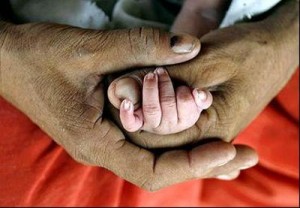In this blog post, Charvi Arora, a student of the University of Petroleum and Energy Studies, Dehradun writes about the importance of paternity benefits to be granted to the fathers in India.
Maternity is a matter of fact, and paternity is an indispensable element. Paternity leave helps a husband support his wife at the time of delivery of the child, while also being present during and the days before and after the birth of the child. It helps the father form an attachment with the newborn child. This is helpful when the father is not stressed about meeting the deadlines of his work and other work stress and rather focus on the needs of the child.
Working women in India, due to the enactment of Maternity Benefit Act, 1961 are given certain benefits before and after the birth of the child for 12 weeks (This will soon be increased to 26 weeks by the Labor Ministry on the recommendation of the Ministry of Women and Child Development).[1] On the other hand, the struggle for the demand for paternity leave has been going on for the past ten years. However, there has been no amendments to current laws.
Importance of the Presence of the Father
Parenting is the responsibility of both the mother and the father. The presence of the father at the birth of the child makes him understand the sensitive needs of the newborn baby. This attachment makes him more helpful towards his wife and makes him a better and an affectionate father too.
 Paternity leave for the father makes the bond of the couple even stronger and special as the father will be more supportive towards his wife and will help share the burden of taking care of the newborn baby.
Paternity leave for the father makes the bond of the couple even stronger and special as the father will be more supportive towards his wife and will help share the burden of taking care of the newborn baby.
It benefits the whole family with increased confidence and comfort with parenting in men. They learn how to take child-care duties and get involved in child lives in the early stages of life.
Laws Relating to Paternity
The history of paternity leaves dates from 1977 when the Central Civil Services Leave Rules introduced the paternity leave, a new concept in the government services.
In India, some of them might not be aware that the Central Government has a mandated paternity leave policy providing leave for a government employee for 15 days to take care of his wife and the newborn child. But the Central Government has mandated certain conditions along with this leave such that the leave can be taken only when the father has less than two surviving children and can avail this leave of 15 days before or within six months from the date of birth of the child. If he does not avail paternity leave within that period, it will be considered as lapsed. He will be paid the leave salary equal to what he draws before taking the leave.[2]
In the western countries, corporations offer long paternity leaves which help a father to take over certain additional responsibilities of the family. For example, an employee receives 13 weeks leave with 80 per cent pay in Italy, eight weeks in Sweden and 45 weeks in Norway, both offering 80 per cent pay to employees on paternity leave. Canada gives its employees 35 weeks of leave with 55 per cent pay. Sweden was the first country to introduce the concept of paternity leaves.[3]
Corporate Agenda
In the corporate sector of India, Human Resource advisors have considered the request for granting paternity leave as new organizations employing young employees need to include these changes to the employee profiles. The corporate sector is planning to provide for equal opportunities with no prejudices towards men or woman.
Traditional and small-scale organizations involved in the manufacturing or construction businesses struggle to introduce new changes in their structure. These changes are necessary because though there is an equal role of both parents in the development of the child at an early age, the father also has an equal responsibility in the nurturing of the child.
In fact, provisions should be amended for the benefit of the fathers so that a progressive environment is fostered in the family.
For providing this leave in private firms, all the suitable measures are to be provided for in the Human Resource Policies of a firm as it is the duty of the HR department to deal with these kinds of matters.
Paternity leave is to be acknowledged equally as maternity leave because gender bias is not taken into consideration in any organizations.
In India, paternity leave is granted in Infosys (paternity leave is provided for five days which is also a paid leave which can be availed for a maximum of 2 children), NIIT (7 days paid leave is awarded) and in Microsoft(2 weeks paid leave is given to its employees).
According to a 2014 International Labor Organization report, at least 78 countries around the world are providing paternity leave to encourage the involvement of fathers in the development of the child. Around 70 countries provide for paid paternity leave.
Introducing paternity leave would benefit the whole society as proper nourishment would be given to the newborn child as it is given everywhere in the world. These ecosystems include access to good crèches, care-giving certification and other social security measures to help support working parents.[4]
A judgment in The Delhi High Court, 2009 passed a decision allowing paternity leaves in private schools.
Conclusion
Some companies in India have also initiated to analyze the importance of providing paternity benefits as a necessity for the fathers and offering various incentives for new employees. Many doctors have advised this as an essential step to not only strengthen the bond between the family but also to help bring about new developments in the economy. In the recent years, India is planning to have a more accommodating policy on paternity benefits compared to other countries. However, many sectors like areas of domestic work, agriculture sector, and small and large-scale production factories within the nation are still struggling to even provide maternity benefits for mothers-to-be, directly violating the Maternity Benefit Act, 1961.
In the recent years, India is planning to have a more accommodating policy on paternity benefits compared to other countries. However, many sectors like areas of domestic work, agriculture sector, and small and large-scale production factories within the nation are still struggling to even provide maternity benefits for mothers-to-be, directly violating the Maternity Benefit Act, 1961.
The need for a work culture that is friendly and cooperative and includes long-term leaves both in rural and urban areas is much needed.
In my opinion, for granting paternity leave to the fathers, they shall be paid salary equal to the pay last received immediately before proceeding on leave. Whereas there is no provision on providing paternity leave in Indian Labor laws for specifically to the private sector employees. The government employees are entitled to 15 days as stated above. Organizations can also provide professional counseling on topics like child care, stress management, and early parenthood. It is equally important and essential that the father takes major responsibility in nurturing the child and therefore, organizations need to support this in all possible ways.
The law gives this provision in the case of an adoption as well. This leave is authorized for government employees in India and as such, no law has been instructed in the private sector to make this leave compulsory. It is open to interpretation by different companies individually. The law should be family friendly and make policies according to it. As the women get certain maternity benefits for giving birth, so the men equally should have a hand in supporting their wives and welcoming the newborn with great happiness. Countless studies have also shown that it is necessary for the father to have affectionate relations with the child at an early stage.
[divider]
Footnotes:
[1] http://epaper.timesofindia.com/Repository/ml.asp?Ref=QkdNSVIvMjAxMS8wNS8wOCNBcjAwNjAw&Mode=HTML
[2] http://www.helplinelaw.com/family-law/MPBI1/maternity-and-paternity-benefits-in-india.html
[3] http://timesofindia.indiatimes.com/life-style/relationships/work/Time-for-paternity-leave-policies/articleshow/47954505.cms
[4] http://scroll.in/article/809769/lessons-from-the-noise-of-urban-innovation-in-dhaka-the-worlds-second-least-liveable-city
 Serato DJ Crack 2025Serato DJ PRO Crack
Serato DJ Crack 2025Serato DJ PRO Crack









 Allow notifications
Allow notifications




I’m grateful sir 🙂
A great and a very humane article by Charvi Arora. Congrats!
thank u sir 🙂 it means a lot 🙂